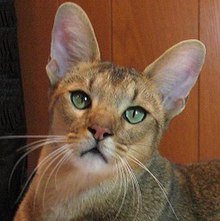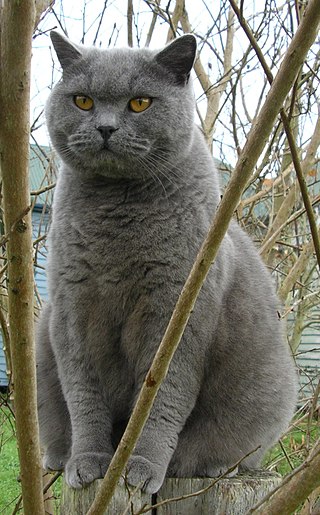
The British Shorthair is the pedigree version of the traditional British domestic cat, with a distinctively stocky body, thick coat, and broad face. The most familiar colour variant is the "British Blue", with a solid grey-blue coat, pineapple eyes, and a medium-sized tail. The breed has also been bred in a wide range of other colours and patterns, including tabby and colourpoint.

The Bengal cat is a breed of hybrid cat created from crossing of an Asian leopard cat with domestic cats, especially the spotted Egyptian Mau. It is then usually bred with a breed that demonstrates a friendlier personality, because after breeding a domesticated cat with a wildcat, its friendly personality may not manifest in the kitten. The breed's name derives from the leopard cat's taxonomic name.

The Birman, also called the "Sacred Cat of Burma", is a domestic cat breed. The Birman is a long-haired, colour-pointed cat distinguished by a silky coat, deep blue eyes, and contrasting white "gloves" on each paw.
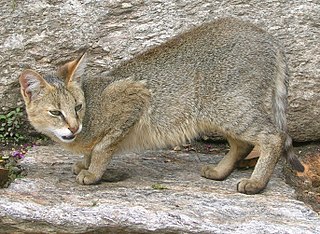
The jungle cat, also called reed cat and swamp cat, is a medium-sized cat native from the Eastern Mediterranean region and the Caucasus to parts of Central, South and Southeast Asia. It inhabits foremost wetlands like swamps, littoral and riparian areas with dense vegetation. It is listed as Least Concern on the IUCN Red List, and is mainly threatened by destruction of wetlands, trapping and poisoning.
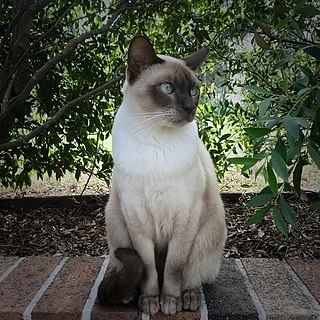
Tonkinese is a domestic cat breed produced by crossbreeding between the Siamese and Burmese. Members of the breed are distinguished by a pointed coat pattern in a variety of colors. In addition to the modified coat colors of the "mink" pattern, which is a dilution of the point color, the breed is now being shown in the foundation-like Siamese and Burmese colors: pointed with white and solid overall (sepia).

Cat coat genetics determine the coloration, pattern, length, and texture of feline fur. The variations among cat coats are physical properties and should not be confused with cat breeds. A cat may display the coat of a certain breed without actually being that breed. For example, a Neva Masquerade could wear point coloration, the stereotypical coat of a Siamese.

The Singapura, or Kucinta in Singapore, is the smallest breed of cat, noted for its large eyes and ears, ticked coat, and blunt tail. Reportedly established from three "drain cats" imported from Singapore in the 1970s, it was later revealed that the cats were originally sent to Singapore from the United States before being exported back to the US. Investigations by the Cat Fanciers' Association (CFA) concluded that no wrongdoing had occurred and the Singapura kept its status as a natural breed.

The Snowshoe is a rare breed of domestic cat originating in the United States of America in the 1960s. The Snowshoe is a short-haired bicolour colourpoint breed. Snowshoes were first produced when a Siamese breeder's cat gave birth to three kittens with white feet. The breeder, Dorothy Hinds-Daugherty, then began a breeding program to produce what were originally called "Silver Laces", crossing the strangely marked Siamese cats with bicolour American Shorthair cats and other breeds. Despite having existed for 45 years, Snowshoes are rare due to the difficulty of reproducing the correct coat markings.
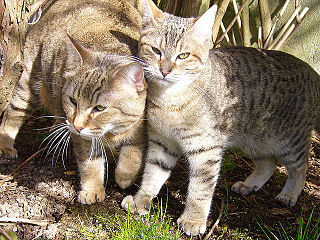
The Pixie-bob is a breed of domestic cat claimed to be the progeny of naturally occurring bobcat hybrids. However, DNA testing has failed to detect bobcat marker genes, and Pixie-bobs are considered wholly domestic for the purposes of ownership, cat fancy registration, and import and export. They were, however, selected and bred to look like American bobcats.

The Sokoke is natural breed of domestic cat, developed and standardised, beginning in the late 1970s, from the feral khadzonzo landrace of eastern, coastal Kenya. The Sokoke is recognized by four major cat pedigree registry organizations as a standardised cat breed. It is named after the Arabuko Sokoke National Forest, the environment from which the foundation stock was obtained, for breed development primarily in Denmark and the United States. The cat is long-legged, with short, coarse hair, and typically a tabby coat, though specific lineages have produced different appearances. Although once rumored to be a domestic × wildcat hybrid, genetic study has not borne out this belief. Another idea, that the variety is unusually ancient, remains unproven either way. The native population is closely related to an island-dwelling group, the Lamu cat, further north.

The Savannah is a breed of hybrid cat developed in the late 20th century from crossing a serval with a domestic cat. This hybridization typically produces large and lean offspring, with the serval's characteristic large ears and markedly brown-spotted coats. F1 and F2 male Savannahs can be very large, and in 2016 an F2 male attained a world record for tallest cat at 48.4 centimetres (19.1 in). Show-eligible F4–F5 cats range from 5.0 to 8.2 kilograms however, comparable in size to other large domestic cat breeds such as the Maine Coon or Norwegian Forest cat.

A felid hybrid is any of a number of hybrids between various species of the cat family, Felidae. This article deals with hybrids between the species of the subfamily Felinae.

The Serengeti is a hybrid breed of domestic cat, first developed by crossing a Bengal and an Oriental Shorthair. Created by biologist Karen Sausman of Kingsmark Cattery in California in 1994, the breed is still in the development stages, but the ultimate aim is to produce a cat that looks similar to a serval, without using any recent wild cat blood.

The toyger is a breed of domestic cat, the result of breeding domestic shorthaired tabbies to make them resemble a "toy tiger", as its striped coat is reminiscent of the tiger's. The breed's creator, Judy Sugden, has stated that the breed was developed in order to inspire people to care about the conservation of tigers in the wild. It was recognized for "registration only" by The International Cat Association in the early 2000s, and advanced through all requirements to be accepted as a full championship breed in 2012. The Toyger Cat Society database lists 30 active Toyger breeders as of 2024.
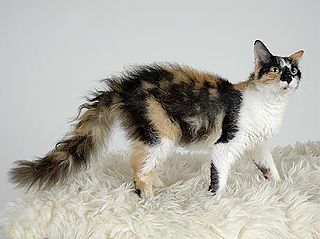
The LaPerm is a breed of cat. A LaPerm's fur is curly, with the tightest curls being on the throat and on the base of the ears. LaPerms come in many colors and patterns. LaPerms generally have a very affectionate personality.

A tabby cat, or simply tabby, is any domestic cat with a distinctive M-shaped marking on its forehead, stripes by its eyes and across its cheeks, along its back, around its legs and tail, and characteristic striped, dotted, lined, flecked, banded, or swirled patterns on the body: neck, shoulders, sides, flanks, chest, and abdomen. The four known distinct patterns, each linked to genetics, are the mackerel, classic or blotched, ticked, and spotted tabby patterns.
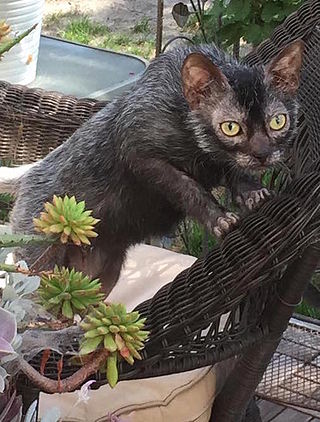
The Lykoi is a breed of cat derived from a natural mutation causing a form of hypotrichia found in domestic short-haired cats. The mutation has occurred in domestic cats over the last 20 years. DNA testing has been done by UC Davis to confirm that the cats do not carry the Sphynx/Devon Rex gene. The breed was developed by Brittney Gobble in Vonore, Tennessee.

The Suphalak or Thong Daeng is a cat variety originating in Thailand. It is of a solid reddish-brown copper colored short-haired coat, and was described in a class of historical Thai manuscripts known as the Treatise on Cats or Tamra Maew. It is often considered an ancestor of the modern Burmese breed or a synonym thereof; others recognize it as a color variety of the native Thai cat breed known as Maew Boran แมวโบราณ), while there have been efforts by The International Maew Boran Association (TIMBA) in Thailand to have the Suphalak certified as a separate breed.

The domestic cat originated from Near-Eastern and Egyptian populations of the African wildcat, Felis sylvestris lybica. The family Felidae, to which all living feline species belong, is theorized to have arisen about ten to eleven million years ago and is divided into eight major phylogenetic lineages. The Felis lineage in particular is the lineage to which the domestic cat belongs.
